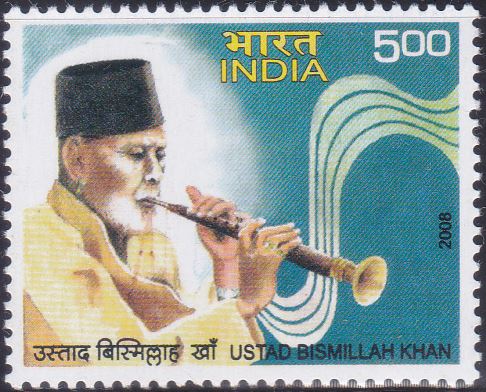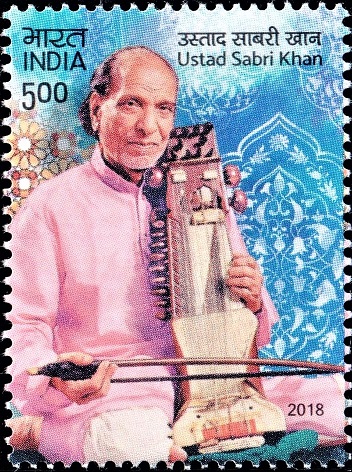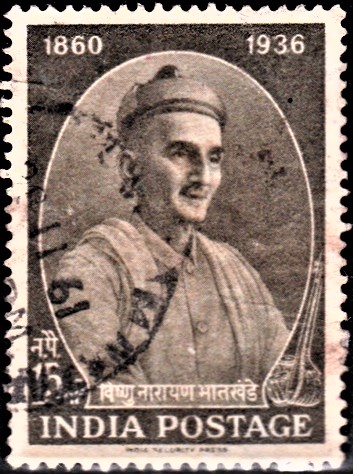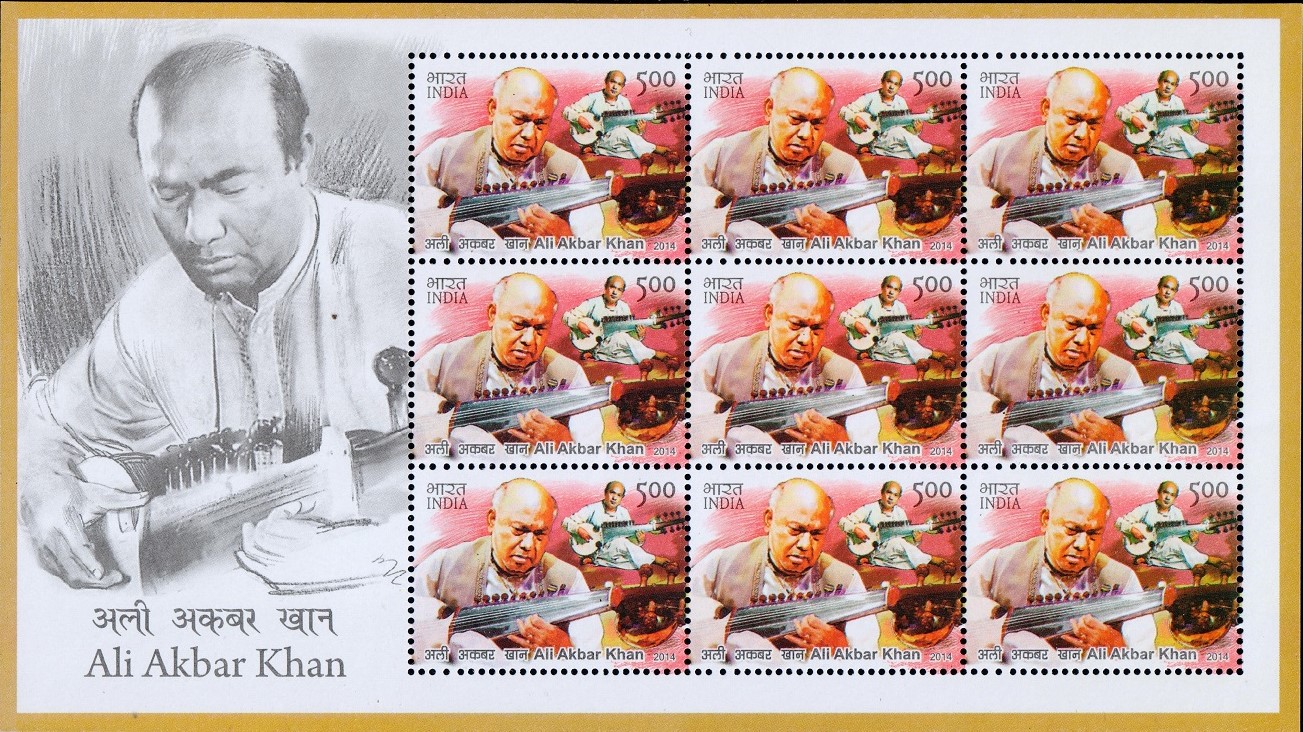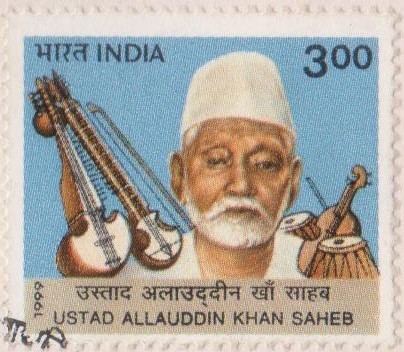
Ustad Bismillah Khan
A commemorative postage stamp on the Death Anniversary of Ustaad Bismillah Khan, an Indian shehnai maestro :
Issued on Aug 21, 2008
Issued for : India Post is proud to release a commemorative postage stamp on Ustad Bismillah Khan.
Credits :
Stamp & FDC : C.R. Pakrashi
Cancellation : Alka Sharma
Type : Stamp, Mint Condition
Colour : Multi colour
Denomination : 500 Paise
Stamps Printed : 0.4 Million
Printing Process : Wet–offset
Printer : Security Printing Press, Hyderabad
Name : Amiruddin Khan
Born on Mar 21, 1913 at Dumraon, Buxar district, Bihar, India
Died on Aug 21, 2006 at Varanasi, Uttar Pradesh, India
About :
- The notion and concept of Sound (Nada) is intricately woven into the spiritual fabric of the Indian tradition. Classical music has been viewed as a “sadhana” (discipline), an existential search through melody. This search for the Self through music is at the heart of all great classical music but has perhaps been best embodied, in the modern era, in the persona and Shehnai of Ustad Bismillah Khan.
- Born on March 21, 1916 into a family of court musicians in the erstwhile princely state of Dumraon in Bihar, Ustad Bismillah Khan was the second son of Paigambar Khan and Mitthan. He learnt the nuances of the Shehnai from his uncle, Ali Bux ‘Vilayatu’, who was the official Shehnai player at the famous Kashi Vishwanath temple at Varanasi. This tutelage not only triggered off his deep interest and study of the Khayal tradition of Hindustani Classical music but also helped shape Bismillah Khan’s eclectic temperament. Bismillah Khan would often say, “…. A musician can play beautifully …. But unless he strives to meet God, he will have only kala (art) but no assar (mystical union) ….. He will always stand at edge of the ocean but never reach the heights of purity”.
- This mystical striving defined the music of Ustad Saheb all his life, from the moment he burst upon the scene at the All-India Music Conference in Kolkata in 1937, playing classical ragas on an instrument which was till then limited to being played in temples on auspicious occasions or in wedding processions. Though his first public performance was at the age of 14 at the Music Conference at Allahabad, it was the Kolkata Conference which established both the musician, Bismillah Khan as a major artiste, and the instrument, the Shehnai, as a major classical instrument. There was a marked change in the way the Shehnai began to be perceived, evolving from being just a Sushir Vadya (Aerophonic Musical Instrument) to a concert instrument playing out intricate ragas. The next seven decades saw the word “Shehnai” becoming so completely synonymous with the name of Ustad Bismillah Khan that one name was enough to conjure up the other.
- Interwoven into his consciousness of music and the Shehnai was his passion for the city of Benaras and its culture – story has it that when the Rockefeller Centre requested the Ustad to shift base to the United States, Bismillah Khan, at first, politely declined, citing his extended family of about 50-60 people who were dependant upon him, but when the Rockefeller Centre offered to relocate them along with the Ustad, Bismillah Khan wistfully asked them to relocate. This disarming simplicity coupled with his frugal personal needs which put him among the medieval saint poets (“Moso Kaha Sikri so Kaam“; what have I got to do with Fatehpur Sikri, Surdas is supposed to have said when called to Akbar’s Court) marked him out as a powerful torchbearer of an ancient tradition where music was more of a journey to attain Anand (the divine bliss) than an exercise aimed towards attaining name and fame. Though he played in almost all capital cities across the world, his heart would find a dozen reasons for quickly returning to Varanasi. Just as the Shehnai seemed to play within him as a soul-companion (he would lovingly called it Begum after the death of his wife), Varanasi too seemed to root his mystical search for the infinite. His haunting rendition of the various ragas on the Shehnai saw him accorded the rare privilege of performing on the occasion of India’s Independence Day, August 15th, 1947, where he played Raag Kafi as well as on the occasion of India’s first Republic day on January 26th, 1950, where he composed and played a tune, “Sange dware badhiye baje”, inspired by the local rhythms of the boatmen at Benaras. Bismillah Khan’s Shehnai has played out on the collective Indian consciousness ever since his recital became an integral part of the Independence Day celebrations on the national channel of Doordarshan every August 15th.
- Many recognitions and awards came his way: Sangeet Natak Academy Award (1956), Padma Shri (1961), Padma Bhushan (1968), Padma Vibhushan (1980) are some of the examples of a nation’s gratitude and affection toward the musical genius. He was also conferred with the highest civilian award ‘Bharat Ratna’ in 2001. He was awarded honorary Doctorates by Benaras Hindu University, Visva Bharati University.
- His musical genius was completed by not his simplicity but his generosity as well – the well-known story of his house at Benaras being christened “Bismillah Hotel”, where food would be provided to every hungry visitor, is testimony to the great values he stood for, which he believed were taught to him by the all-encompassing spirit of music. “Music alone knows no caste”, he would say, “…. and even if the world was to end, music would still to survive”. His mesmerising playing of the Shehnai was a call of the inner Self, his music was a melodic idiom exhorting the listener into an inner spiritual space, his life was a reminder of the need to transcend the externalities of religion and caste.
- Bismillah Khan had a brief association with movies. He acted in Satyajit Ray’s ‘Jalsaghar’ and provided the haunting tunes of Shehnai in the movie ‘Goonj Uthi Shehnai’.
- Bismillah Khan fell ill on 17th August, 2006 and four days later on August 21, 2006 he passed away at the age of ninety.
- This “Bismillah of Benaras”, as he is sometimes called, was a living metaphor of the great pluralistic traditions of India and for Ustad Saheb, this need to bond with every being was defined completely by the search for the perfect “Sur” (Note). As he himself so eloquently puts it, “…. sur is a clean thing, a pure thing. It is like a mirror in which you see the world, in which I see my own face when I play….when the sur clicks, it is like I am unconscious and the heart has taken over. Sometimes I don’t understand who’s playing…..am I at the Manzar or in the presence of ancient Sages….all I can think of is Hey mere Malik, Mujhe lele, tu hi nirankar hai…” (O God, take me away, you alone are formless…).
- Text : Pranav Khullar.
Subscribe
Login
0 Comments


